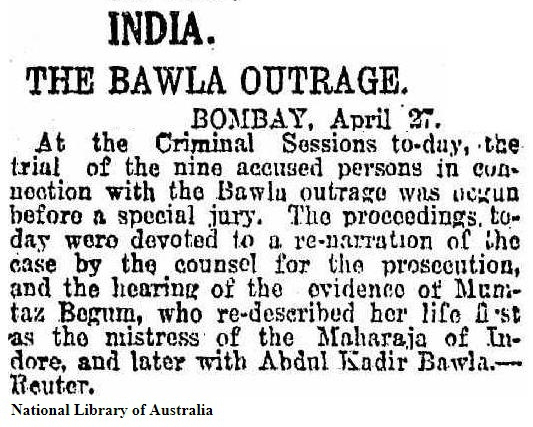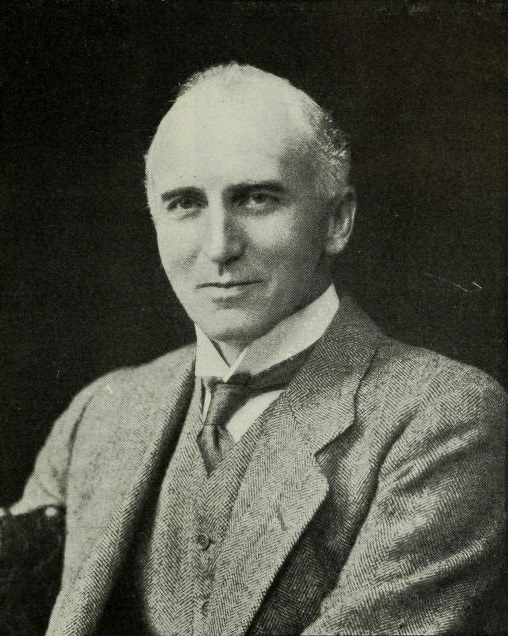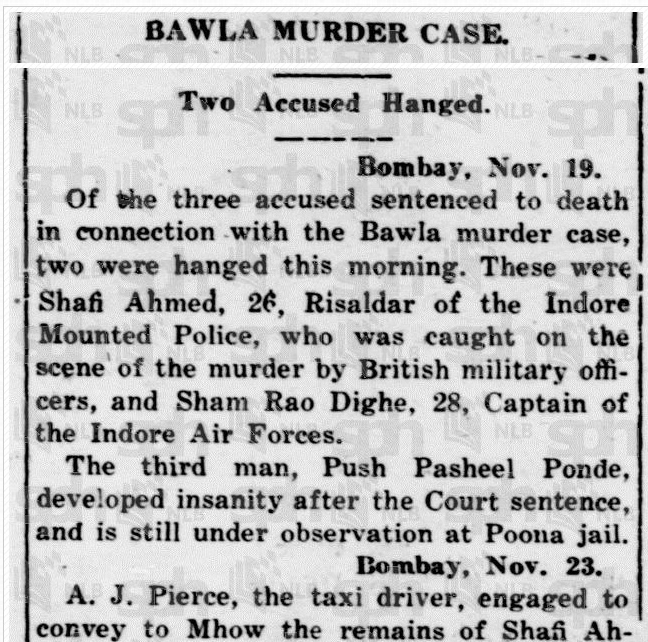3Ms and Bawla – The Case That Rocked India
Written by : Amita Roy
Dated: January 11,2018
Share

Mumtaz Begum with a Sarangi player in 1924. Source - Historic Images
1925 –
12th January, 7.25 pm, Malabar Hill
Hanging Gardens, the beauty spot of Bombay which is also a frequented promenade, suddenly witnesses a break in its tranquil and peaceful ambiance. There was still twilight, many people were strolling along the road and there was brisk vehicular movement. A motor car with driver and manager Mathew in front, a man and a woman seated at the back drove towards the Hanging Gardens at the top of Malabar Hills through Gibbs road from Kemps Corner. Almost immediately, a red Maxwell car having 6-7 men bumped into this car deliberately, halting both the cars. The inmates of the Maxwell car jumped out of the car hurling abuses at the man of the first car. They surrounded the first car from both sides, two or three men mounting the foot-boards on either side. The first car belonged to one Abdul Kadir Bawla, a wealthy businessman of Bombay.
 - 19th Century Photograph(4).jpg)
Malabar Hill in 19th century Bombay. Source - Google Images
The woman in the car was none other than Mumtaz Begum, a beautiful Muslim dancing girl from a Hindu mother Sowkabai Pandharinath who was both decoyed from Bombay to Indore in 1915 by Maharaja of Indore Tukojirao Holkar. Mumtaz Begum was kept as a mistress in the zenana of a fort near Indore for almost 11 years. Mumtaz Begum was so fed up with her gilded life in the princely harem of the Holkar that she fled or was released in April 1924. Initially, she traveled to many places from Delhi to Nagpur but ultimately found consolation and a safe haven with a young rich businessman of Bombay named Abdul Kadir Bawla. This escapade caused a huge furor in the prestige and esteem of the Indore Durbar and hence it was a seen as a blow to the manhood and dignity of both Maharaja and Indore Durbar. Therefore, it was decided that the runaway Helen of Indore should be brought back and punished. Her whereabouts in Bombay were traced, a gang of 9-10 rogues were hired to teach a reminder to the fickle fugitive and her enamor for meddling with the harem affairs of a Maharaja.
On the said evening, the goons in the red Maxwell had the intention of kidnapping Mumtaz Begum by force. They tracked her down and overtook her car. The gang was armed with pistols, knives and kukris. After jumping out from Maxwell, they tried to snatch Mumtaz from the side of Bawla. She started resisting and cried out for help. Bawla tried his best to shield her but the gang slashed her face 4 times with a knife, partially disfiguring her face. Simultaneously, more than one shot was fired at Bawla who got seriously wounded and died shortly after. In fact, according to the evidence of Mumtaz, one of the men who had boarded Bawla's car aimed and fired a pistol at him almost immediately after mounting the footboard.
But somewhere a piece of luck visited her. When this outrage was peaking, it seems a car came out of the blue hearing the shots and the screams and cries of a woman. The inmates of this 3rd car stopped their car and jumped out of it to rescue the victims. The inmates of this rescue car were 3 in number – all English military officers; Lt Saegert who was driving the car and 2 more inmates Lt Stephen and Lt Batley. Saegert over powered 2 or 3 of the assailants snatched Mumtaz out of the hands of the kidnappers and rescued her despite being wounded and receiving 3-4 gun shots in the body. His comrades also assisted him in the thick of this situation. Shortly after, another military officer Col. Vickery drove up and these bravados succeeded in capturing 1-2 miscreants. They were handed over to the police who came immediately after. Beside, Lt. Saegert had inflicted a knife injury in the neck and injured a miscreant with his golf stick.
(1).jpg)
Lt. Saegert
The arrival of these gallant soldiers just on the nick of time was a super fine stroke of luck. They had come to play routine golf at Willingdon Club and then drove through the Peddar Road. But instead of taking lower Hughes Road to reach their barracks in Colaba, they took upper Gibbs Road and accidentally reached the spot on time.
The entire crime scenario on spot seems to be crime potboiler right?! Full of suspense, intrigue, revenge, romance and every spice that a murder mystery should have!!
PROSECUTION
The prosecution of this case started immediately unlike modern day criminal cases in India which takes years to decades to solve the murder mystery and punish the criminals. The entire prosecution was wrapped up within 1925 itself which can be said as equal to modern day fast track courts in India. Given it was after WWI and India was the richest colony of Great Britain under the Crown, this type of revenge cum romance was very much uncommon in Indian society, lest English society. The case not only shook the high society and Press in Bombay which was a British Presidency but also shook the entire country and rest of the world. Not only Indian press made huge coverage on the story with multiple presumptions and assumptions, but globally also, Press in other British colonies or English speaking countries covered it widely.
Looking back, when we read these newspapers or the verdict passed by the British Judiciary in India, the flow of prosecution made this case the most sensation criminal case of its time in India whose memory was still fresh in the minds of the public even after few years. It was also 20th century India’s one of the first high profile murder mysteries. The case also witnessed some of the top names in Indian and British legal system defend both appellate or the defense.
(1).jpg)
Mohd. Ali Jinnah. Image - Getty
The trial started in the Criminal Sessions of the Bombay High Court in 1925 itself. Nine men were put up who were charged with being members of a criminal conspiracy to kidnap Mumtaz Begum out of British India, for causing her grievous injury and attempt of her kidnap, along with the murder of Bawla. They were tried before Justice Crump and a special Jury. Advocate J.B.Kanga and with Kenneth Kemp appeared for the prosecution. Big names like Jinnah, J. M. Sengupta, S.G. Velinkar defended the accused.
(1).jpg)
Wide press coverage of Bawla murder trial in 1925.
Court of law studied the case from different angles, circumstances, evidences and multiple witnesses. As there was multiple number of accused involved in the same crime, the trial took several days and drew large number of crowds as spectators in the High Court. The main witnesses were the three military officers and Col. Vickery whose trained eye as military personnel gave vital testimonies which helped in convicting 6 out of the 9 accused. With so many people accused for the same crime on the same spot within a very short span of time, the Judiciary was careful and made it ensure that no injustice was done and right people were convicted. The Defense tried to prove that Bawla who already had a revolver license shot first from his revolver. But the ballistic test proved otherwise. The bullets extracted from Bawla’s body or Saegert’s didn’t match to that of his revolver or the bullets and cartridges found on the scene of crime. Rather they matched that of the assailants.

Press coverage when the murder trial began in April, 1925.
The Defense also tried to prove that Mumtaz Begum was ready to go to Indore on her own will but circumstantial evidence as well as her previous lawyer prior to this incident testified that Mumtaz Begum never ever wanted to go back to Indore. In fact she had disclosed to her previous lawyer Mr Nariman that she would rather get drowned in the sea than going to Indore.

Sir John Simon. Source - Wikimedia
In the entire trial, Indore cropped up zillion of times. But why even though Mumtaz was a mistress of Holkar harem, it does not mean that the Indore Durbar may have been involved in it, directly or indirectly?! Who were these miscreants?!
Given the complexities in the case, the Bombay Bar Association states in their journal later –
“Apart from the clear, direct, and unimpeachable evidence led by the prosecution, the jury was assisted in forming a clear picture of the crime and of the legal aspects of the case, by the masterly summing-up of Mr. Justice Crump. This summing-up stands in a class by itself in the history of the Bombay High Court. It covers 145 typed folio pages. The first 40 pages are devoted to preliminary observations as regards the general aspects of a criminal trial, the relative functions of judge and jury; and indicating the caution and the safeguards imposed by law, which the jury has to bear in mind, in order to arrive at the right verdict. The judge pointed out and explained the various sections of the Penal Code under which the different accused were charged, the legal requirements which were necessary to prove the charges, and expounded the legal position with an elaboration, meticulous care, and analytical precision which left little to be desired. Perhaps, there was over-elaboration of the legal position; but as the judge pointed out, it is safer to repeat things too often than to leave anything unsaid. He also pointed out that in a criminal trial with a number of witnesses who look at or are concerned in an occurrence from various standpoints, minor discrepancies are bound to occur; and in fact, these discrepancies prove the general truth of the evidence; the safe practical rule being to look for substantial agreement on the main facts with circumstantial variations. It was indeed a model charge; and it is said that the Chief Justice, Sir Norman Macleod, was so much impressed with the clearness, completeness and cogency of this charge, that printed copies of it were made and ordered to be distributed among Sessions Judges in the mofussil.”
Among the accused, the Judge and the Jury selected Shafi Ahmed, Pushpasheel Balvantrao Ponde and and Shamrao Revji Dighe to be sentenced to death. Another prime accused Sardar Anandrao Gangaram Phanse who was found to be guilty of plotting the kidnap of Mumtaz Begum and murder of Bawla, was sentenced to life imprisonment due to his star lawyer Mohd Ali Jinnah arguing that he was not physically present at the murder scene. The most distinguished lawyer of the era, Sir John Simon was also involved in this case. He is the same Sir John Simon after whom the Simon Commission was named and formed to look after constitutional reforms in India, Britain’s most important colony. The Bombay Bar Association states further in their journal :
“An application for special leave to appeal to the Privy Council was made on behalf of the convicted persons. They engaged one of the ablest and most distinguished lawyers of the time, Sir John Simon. Two points were taken before the Judicial Committee: (1) the great prejudice created against the accused persons in Bombay by reason of the case having been discussed and commented upon by various local newspapers in Bombay prior to the trial. In order to ensure a fair trial and an unprejudiced jury, the Governor-Genera] ought to have transferred the case under s. 527 of the Criminal Procedure Code from Bombay to some other jurisdiction, where the atmosphere was free from local excitement and prejudice. The second point taken was that the judge's charge to the jurors did not adequately bring home to them that abetment of murder could not be properly and legitimately inferred from a mere conspiracy to kidnap, unless the natural and inevitable consequence of an attempt to kidnap was murder. Their Lordships of the Privy Council dismissed the application, observing that even in an appeal, ordinarily the Board did not review or interfere with the course of criminal proceedings, unless it was shown that, by a disregard of the forms of legal process, or by violation of the principles of natural justice or otherwise, grave and substantial injustice had been done to the persons convicted. Referring to the first ground taken before them, viz., that the refusal of the Governor-General to transfer the case from Bombay was an adequate ground for admitting the appeal, Their Lordships remarked that the Governor-General was the best and the only person who could form a proper judgment on the matter, he having all the advantages of being in the country and of judging the real state of public feeling. To suggest that the refusal of the authorities in India to transfer the case from one jurisdiction to another amounted to a violation of the principles of natural justice, was nothing less than preposterous. As regards the second ground, they observed that even if they were a court of criminal appeal, it would be very difficult to say that the learned judge's charge to the jury was inadequate; but at any rate, at the stage at which they were for the time being, it was impossible to say that the inadequacy or otherwise of the charge amounted to a disregard of the forms of legal process, or violation of the principles of natural justice. In the result the application was dismissed.”
Later on a November morning in 1925, Shafi Ahmed who was a Risaldar with Indore Mounted Police and Shamrao Dighe, a Captain with Indore Air Force were hanged. Ponde developed insanity at Poona Jail and was kept under observation there.

Press coverage when the convicts were hanged in November 1925.
LONG TERM INFLUENCE
As 6 out of 9 convicted in the trial was found out to be in the service of Indore Durbar, somewhere, directly or indirectly, officially or unofficially, the name of the Maharaja of Indore did get dragged into all of this and also was the fact that Mumtaz Begum was his mistress for almost a decade. The British Govt formed a Commission of 5 members to advise the Viceroy about the locus standii. The Commission included of a High Court Judge and 2 Ruling Princes. The Viceroy will take a stand as a direct representative of King Emperor. Due to tremendous pressure from the British Govt, Maharaja of Indore Tukojirao Holkar abdicated his throne in favor of his only son, Yeshwantrao. Strangely, Tukojirao;s father, Maharaja of Indore Shivajirao Holkar also had to abdicate his throne in 1903 due to a mysterious murder of a British Resident which compelled Lord Curzon to pressurize him.
(1).jpg)
Maharaja Shivajirao Holkar. Image - Wikimedia
The abdicated Maharaja Tukojirao Holkar started life afresh in France where he settled down again with a third marriage and this time to a rich American heiress who was popularly known as Maharani Sharmishthabai Holkar. Maharaja Tukojirao Holkar went on to live 5 more decades spanning France, Indore, Bombay and USA.
(1).jpg)
Maharaja Tukojirao Holkar Image - Lafayette Studio
The central character of this story, the dancing girl Mumtaz Begum went on to marry a man named Abdur Rahman in the March of 1926. Mumtaz Begum had returned to Indore, took Purdah and started living with her parents. Abdur Rahman was a rich skin leather manufacturer and a Municipal Commissioner. But later it was said that Mumtaz Begum had a daughter from Abdul Kadir Bawla, though later she had many other children of her own.In the later part of the 1925 itself, this story was made into a Hindi movie called Kulin Kanta. The long term influence of this trial was that it proved the power of press and media for the first time in modern India that facts can be circulated as well as distorted. It became a yard stick of measure for other future high profile society crimes.
(1).jpg)
Mumtaz Begum. Source - Ebay
The uniqueness of the case was that it was the first high profile murder case of modern India where Press did not leave any stone unturned to encash on the curiosity of general public.
